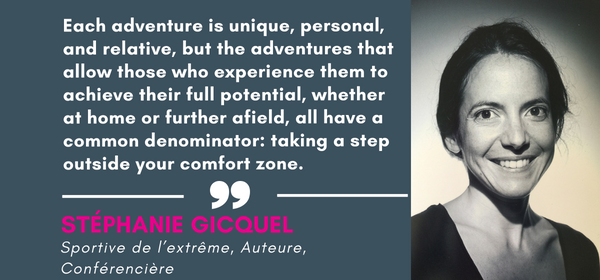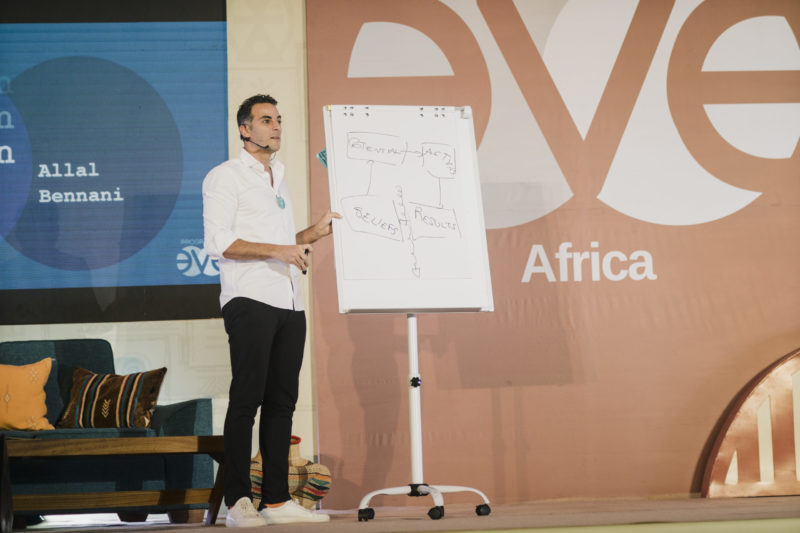I grew up with a persistent and very clear elitist, black and white image of what adventure should look like. Male explorers represented adventure, they often came from “good” families, and most of those explorers had grown bushy beards by the end of their journey. There were few or no women. I then met many explorers personally, on all continents, from the North to the South Geographic Poles.
And then I discovered that adventure had a thousand other faces, ones that were even more radiant, even more feminine. Startuppers who create, managers who take on new projects, parents who respond tirelessly to their children’s questions, teachers who learn from their young charges as much as they share their own knowledge, athletes who embark on new challenges. These are also the faces of adventure, and I have met many of them outside my own front door, in coworking spaces and in businesses, much more than in far-flung destinations.
Each adventure is unique, personal, and relative, but the adventures that allow those who experience them to achieve their full potential, whether at home or further afield, all have a common denominator: taking a step outside your comfort zone, heading towards your desire to be, and letting life shape itself by overcoming obstacles, ups and downs, experiencing change.
Adventure is the key to happiness
In every environment I have experienced, with no exceptions, I have encountered a loss of meaning or unhappiness in those who do not dare to change, who have lost their pioneering spirit, including in the fields of exploration and sport, which are too often idealized.
The key to happiness is not doing one specific thing or another, and it’s especially not doing things whose advantages we can only see if we cover up their disadvantages. It is not found by idealizing limitless exploration, idealizing a brand entrepreneurship free from subordination, nor it is in any other form of ideal. It is not contained within a predefined box, nor is it restricted to a select few. It is not limited by what a person owns or does not own. It does not hide behind the goals we set out to achieve, nor in other people’s dreams.
Happiness lies cradled in self-fulfillment, the achievement of your desire to be. On life’s steep and winding staircase, a feeling of fulfillment comes when body and soul, perfectly aligned, stop peacefully after climbing from step to step, overcoming obstacles, negotiating the adventures that give meaning to life.
Tips for setting out on an adventure
- Trust yourself
The goals we set for ourselves rarely depend on who we really are at any given time. They depend more on our self-image, the confidence we have in our ability to surpass ourselves, an ability that will drive us forward to travel the distance and cross the finish line regardless of the starting point, even if it takes longer than we thought.
- Accept to lay yourself bare
Capitalizing on the experiences we have is a form of self-capitulation. The fear of missing out on the benefit of past experiences, the benefit of what has been built and accumulated, sometimes obscures the even greater risk of not living life to the full. Like someone who climbs summit after summit without daring to make his dream of sailing on the open seas come true.
But it’s not easy to lay down those shackles, to get the most out of a new experience. It means not only detaching yourself from the deceptive desire for recognition, but can also mean disappointing people, being seen as crazy. To really set yourself free, I think it’s essential to be able to draw on the resources you need to show independence of mind and learn to appreciate other people’s success, what makes them unique, to take inspiration from them.
- Make the first move
Often invisible prison walls creep up inside our own heads. They lock us inside, leaving us unable to move and preventing us from taking the first step towards change. The first step is the decision to go for it, to commit to something new. The starting point is the same for everyone, no matter what the change may be. A talk with your inner self, faced with the unknown, with your back turned to the status quo, awash with fear and doubt, surrounded by the prison walls of immobility and conformity, from which it is never easy to escape.
There’s no point in waiting in the hope that these walls will fall down by themselves. You’ll die first. The only way out is to make the first move, take the first step towards the unknown, with your fears and doubts on your shoulders, distancing yourself from the status quo as far as you can. Making each step a source of additional strength or energy.
- Always stay optimistic
Optimism makes the adventure more enjoyable: looking on the bright side enables you to see the possibilities that lie behind each difficulty. When an obstacle stands in your way, you can decide to see the negative side or the positive side, you can consider the obstacle as a setback or an opportunity.
After my expedition across Antarctica, people often asked me what I would do differently if I could start all over again. I would not change a thing. I would keep every moment the same, including the most challenging, the times when I really struggled. I have always thought that a feeling of fulfillment depended on the obstacles to be overcome. After travelling 1270 miles across Antarctica, on a 74-day expedition, in temperatures of -58°F, after a long final day of walking for more than 16 hours, after crossing the last crevices with both knees on the ice, I was even more certain of it.

From the suburbs of Toulouse to Paris, from a high school classroom and a prestigious Grande Ecole (HEC 2006) to a host of perilous polar expeditions, even to the icy extremes of the planet, from law firms on the Champs-Elysées to extreme trail running and conferences around the world, there is just a single step. Stéphanie Gicquel is one of a handful of explorers to have crossed both the Geographical North and South Poles. This extreme sportswoman does ultra-distance running (90 to 125 miles) and participates in charity expeditions, mainly to the Arctic and Antarctic. As the first French woman to run a marathon around the Geographical North Pole in temperatures of -22°F, she also crossed the Antarctic on foot via the South Pole, covering 1270 miles in 74 days, in a temperature of -58°F (Guinness World Records). Author of the books “Expédition Across Antarctica” (Vilo Edigroup, Preface by Nicolas Vanier, René Caillié Literary Prize 2016) and “On naît tous aventurier” (Ramsay Edigroup, May 2018), Stéphanie Gicquel gives regular presentations in companies and for the media on change, daring, adaptation, perseverance and surpassing oneself.
Translated into English by Ruth Simpson






